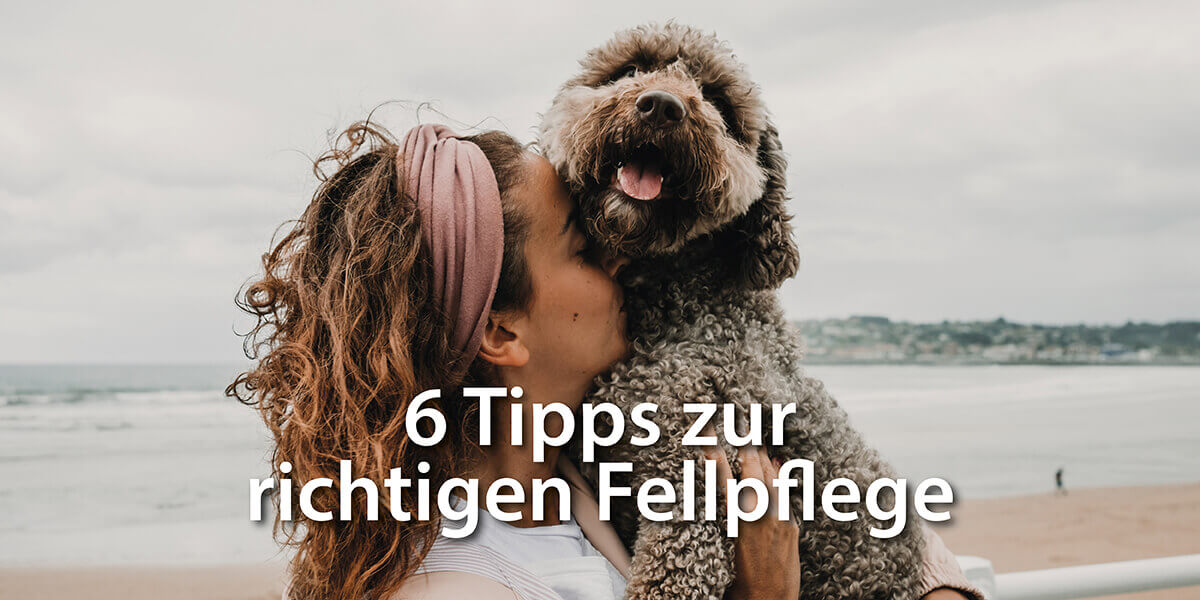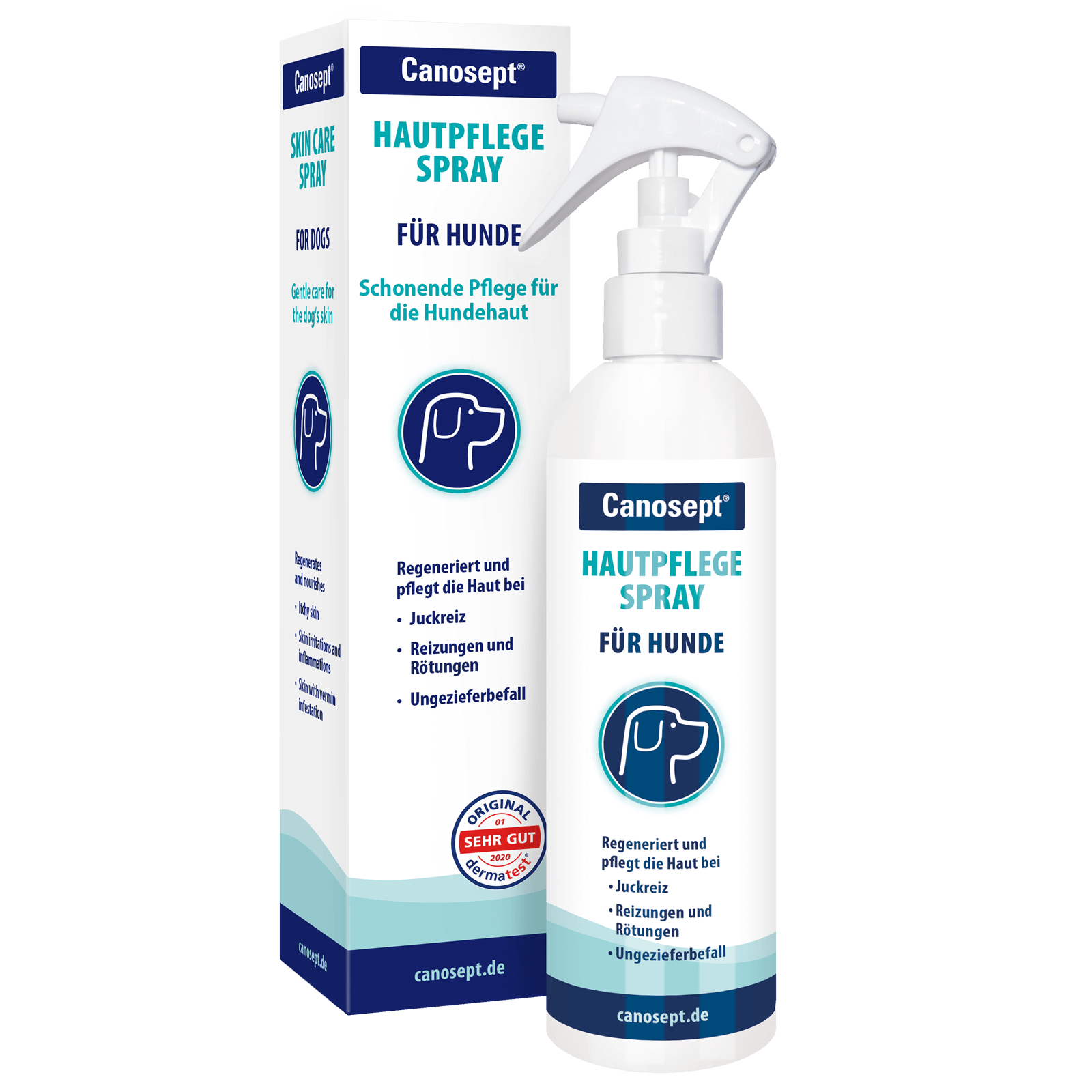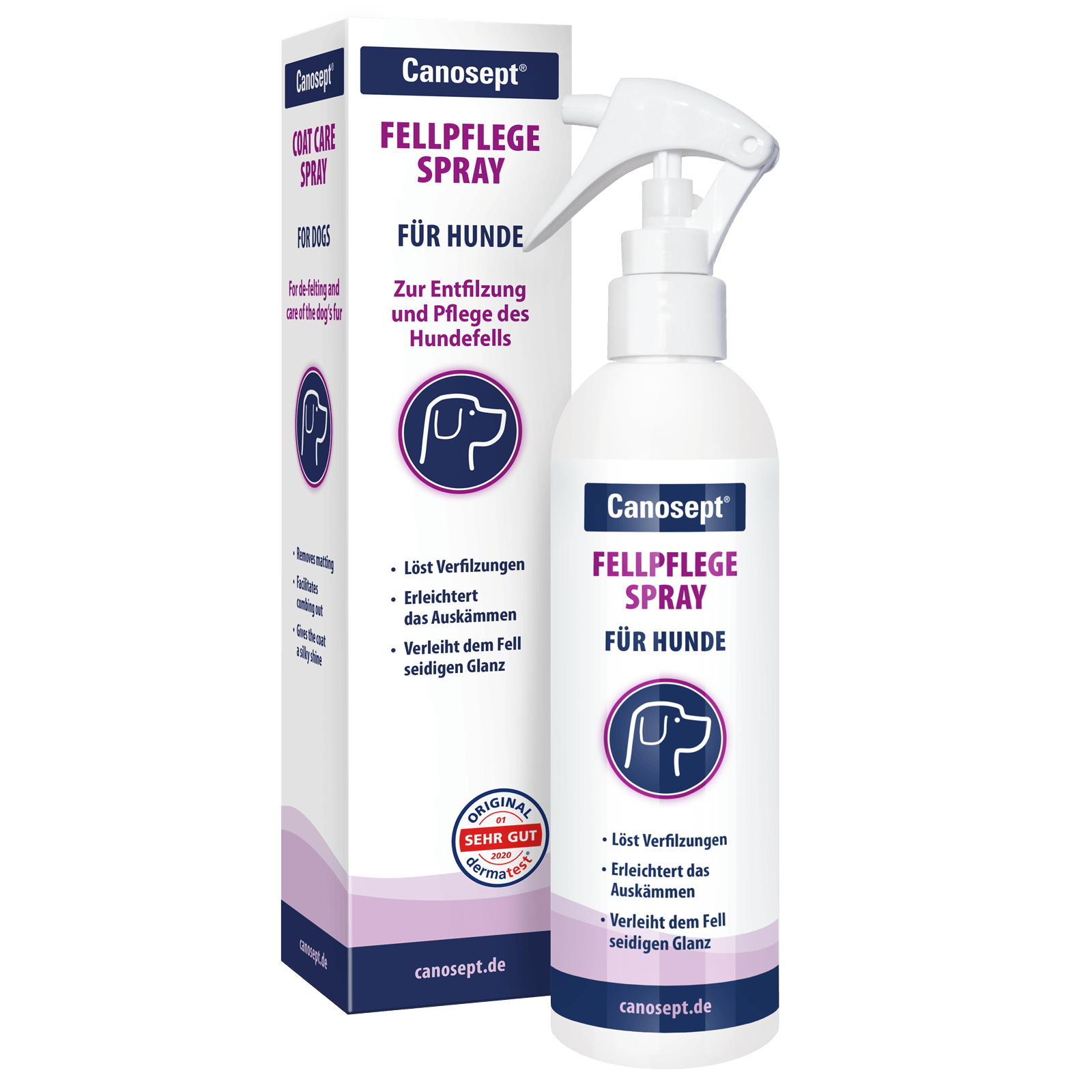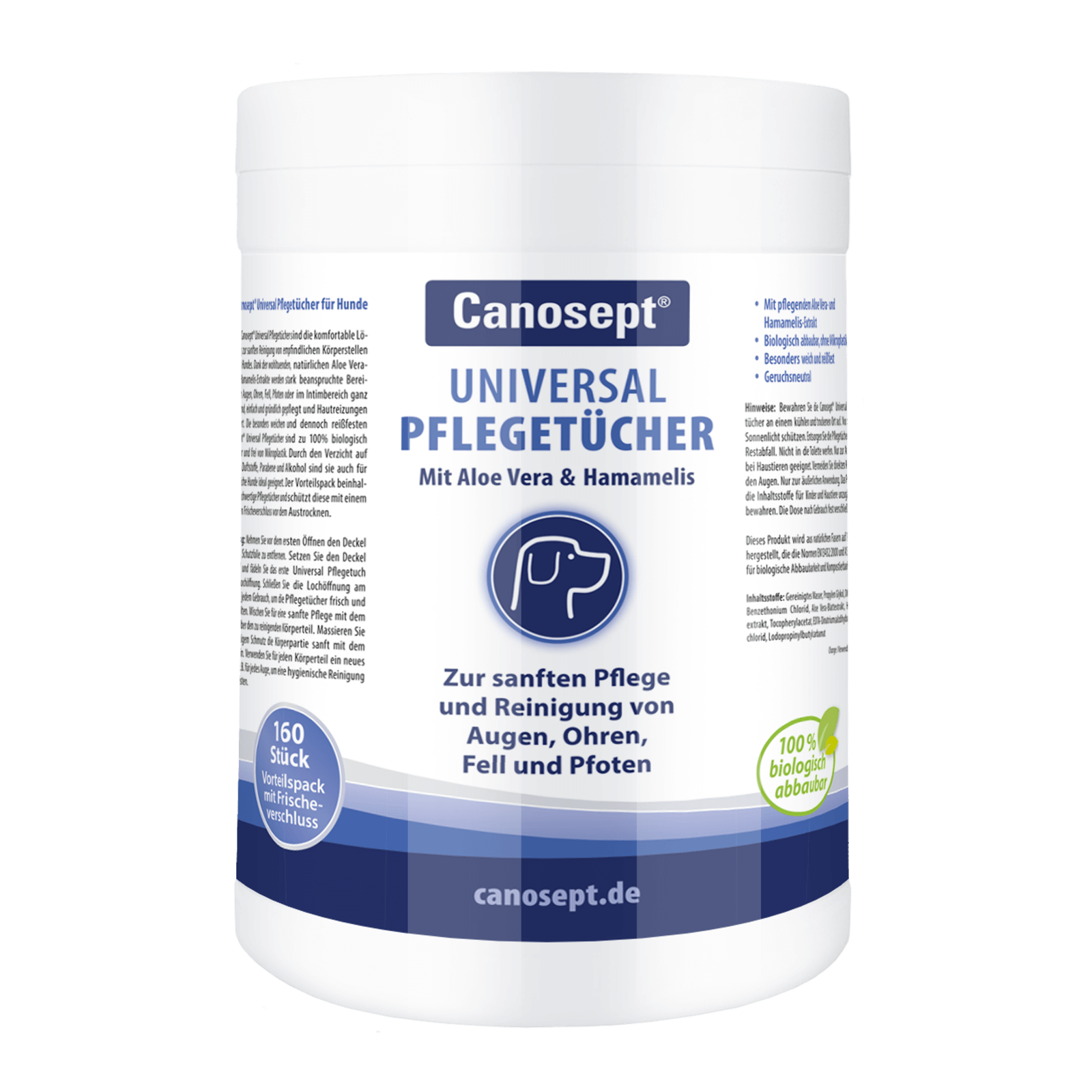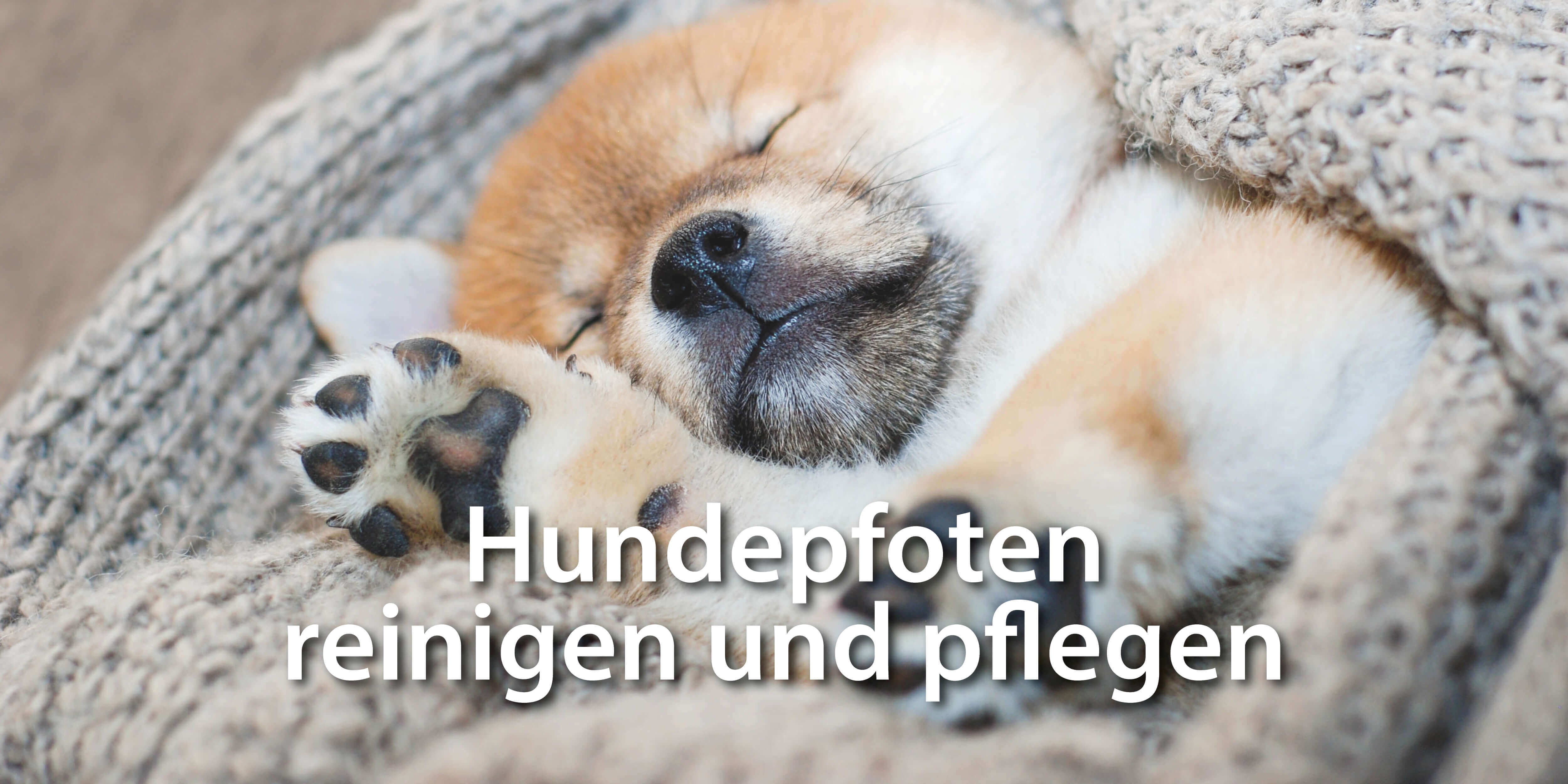
6 tips for dog grooming
Tip 1 for dog grooming: Brush without pulling and tugging
The paws, the areas around the genitals, under the armpits, on the muzzle and on the head are particularly prone to matting in dogs with long hair.
Do you want to spare your dog the painful plucking and combing of his coat? Our Canosept coat care spray makes the coat easier to comb and prevents snagging and knotting.
The natural ingredients prevent matting and seal the dog's fur with a protective film that repels dirt, dust and water.
Tip 2 for dog grooming: Better brushing than shampooing
When it comes to shampooing your dog, your rule should be: as often as necessary, as infrequently as possible. Therefore, try brushing dirt out of the coat first or showering with clean water only.
Bathing your dog's coat may only be necessary if it's heavily soiled, after rolling in carrion or feces, or before clipping. In any case, you should always use a special dog shampoo.
Tip 3 for dog grooming: Only brush dry fur
As with human hair, it's gentler on your dog's coat to brush it only when it's dry. Then the cuticle is closed and less likely to be damaged.

Tip 4 for dog grooming: Skin check when brushing
Dog parents have a lot to keep in mind. This includes detecting skin changes early. By checking your dog's skin while brushing, you can accomplish two dog grooming tasks in one fell swoop.
This also allows you to detect injuries and treat them promptly. Skin irritations, such as dry, brittle, flaky, or irritated areas, indicate a compromised skin barrier, which can be quickly soothed with Canosept Skin Care Spray with natural whey and ash extracts.
Tip 5 for dog grooming: Remove harness or collar at home
Remove the harness or collar at home. This not only protects the hair but also allows the skin to air out. The hair under the collar is exposed to constant friction and is therefore more likely to break off and become dull.
Tip 6 for dog grooming: Adding high-quality oils
With the help of high-quality omega-6 and omega-3 fatty acids, you can support coat growth directly from the root. Salmon oil or cold-pressed vegetable oils such as safflower, hemp, or linseed oil have proven effective when added to the food.
If adding oil is new to your dog, increase the dosage in small increments to prevent diarrhea.

How can I get my dog a beautiful, shiny coat?
A shiny coat on a dog is not only pleasing to the eye, but also an indicator of your dog's health. A dull coat usually indicates a nutritional deficiency or parasites. Successful dog grooming requires more than just brushing.
Dog grooming - The right food
Are you wondering what food has to do with dog grooming? The wrong food is one of the most common causes of dull fur. This is because food absorption through the intestinal mucosa and a healthy composition of intestinal bacteria are important for a dog's health. You can also see this in healthy skin and a shiny coat.
Important for coat health: many nutrients
For healthy skin and a shiny coat, your dog needs plenty of nutrients. These include not only proteins and vitamins, but also essential fatty acids, trace elements, and minerals.
Proteins
Your dog should consume plenty of protein through its food. Protein plays a wide variety of roles, whether in the musculoskeletal system (muscles, tendons, ligaments) or for the skin and coat. For example, the natural protein keratin ensures, among other things, a strong hair structure, hair growth, and resilience. Proteins are also particularly important for the immune system, metabolism, and cell formation.
Essential fatty acids
Omega-3 and omega-6 fatty acids cannot be produced by the dog's body itself. Therefore, it's important that your dog's food contains these essential fatty acids. Among many other health benefits for dogs, they strengthen the hair structure, improve skin density, and increase elasticity.
Vitamins
Vitamins are also important for a dog's coat. Not only for maintaining the hair, but also for its formation and renewal. Vitamin H, also known as biotin, as well as vitamins A, B, and E are particularly important.
Trace elements and minerals
Other important components of the food are zinc, calcium, and copper. The intake of these trace elements and minerals strengthens the hair roots and prevents hair loss.
Brewer's yeast is a great way to provide your dog with valuable trace elements and vitamins. However, this should always be done in consultation with your veterinarian to avoid overdose or undersupply, as both are detrimental to your dog's health.

Dog grooming – parasite control
An unkempt coat can also lead to a parasite infestation. Fleas, mites, and ticks thrive on the warm, moist skin beneath matted fur. In addition to regular brushing and combing, dog grooming also includes regular parasite control, for example, with a flea and dust comb from ARDAP.
Dog grooming – The right dog brushing
Regular brushing is a key part of dog grooming. If left uncombed, the fur can become tangled and matted, and the skin can suffer. It can also lead to itching or dandruff.
Simply brush your dog? This is how you groom your dog's coat
"Why should I get my dog used to being brushed? It's no big deal, is it?" Many dog parents aren't aware that brushing can be a major stress factor for their dog. That's why it's important to get your dog used to being brushed.
It's important that your dog sees grooming as a relaxing routine. Your dog should also learn that you decide when it's time to stop.

Brushing your dog – How to get started
When you begin grooming your dog, you can start with something pleasant for both you and your dog: cuddling! Stroking his head and belly will help get your dog used to being touched. If your dog accepts these touches, you can repeat the same movement with a soft brush. Therefore, grooming your dog is not just a form of grooming, but also an excellent way to strengthen your bond with your dog.
The first grooming sessions should be limited to 1-2 minutes. If your dog stays still, reward him with lots of praise or a treat. For particularly impatient dogs, a licking mat or Kong is a great way to get your dog used to grooming. Licking calms the dog and makes the first grooming attempts easier.
The brush or comb should become a natural grooming tool when caring for your dog’s coat.
How do I brush my dog?
When grooming your dog, work your way through the coat from front to back. Brush or comb in long strokes in the direction of hair growth. This promotes blood circulation and stimulates the metabolism.
The Canosept coat care spray not only makes brushing or combing easier, it also prevents matting and seals the dog's coat with a protective film that repels dirt, dust, and water. This can help prevent itching.
How often should I brush my dog?
- Shorthair: weekly
- Long hair with undercoat: daily as needed and weekly grooming
- Long hair with little to no undercoat: daily as needed and weekly grooming
- Wirehaired: weekly
- Curly/frizzy hair: 2-3 times a week
During the coat change, it is best to remove dead hair from your dog daily.
Which brush or comb for my dog?
- Long, woolly coat: Combs or brushes with long and rounded teeth
- Rough-haired breeds: Short-toothed brushes and combs
- For dense undercoat: Coarse dog brush or special plucking brush
Ask your pet shop or breeder for advice on which brush shape is ideal for grooming your dog's coat type.

